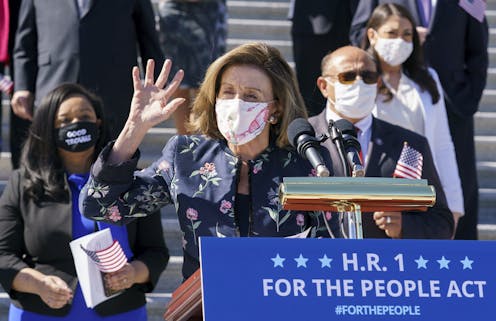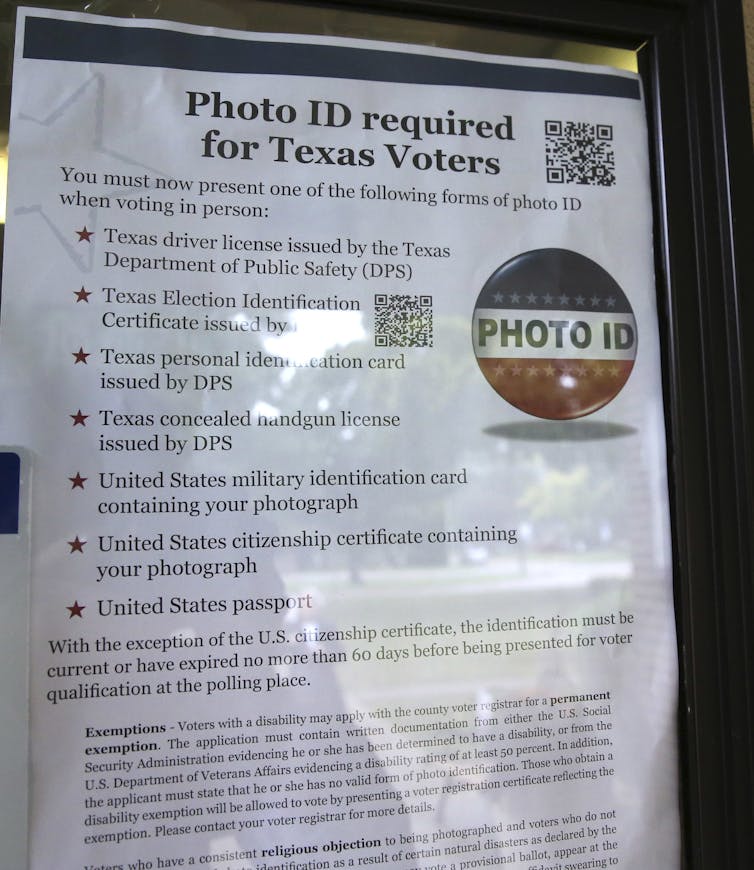Democratic bill attempts to undo voter restrictions of past 15 years
As GOP-run statehouses across the country tighten voting restrictions, a bill in Congress would, its Democratic sponsors say, undo more than 15 years of moves to make voting harder.

The recent national elections — conducted in the middle of the COVID-19 pandemic — highlighted difficulties Americans face to register to vote and cast a ballot. But the right to vote can be equally diminished when voters cast a ballot but their voice is diluted by gerrymandering and other means.
With the For the People Act of 2021 (H.R.1), sponsored and passed in the House by Democrats and unanimously opposed by Republicans, Congress is now considering legislation to address many of these problems.
These are not new problems. In my experience as a voting rights attorney who teaches the subject in law school, most of the voting rights problems addressed by H.R.1 have grown unchecked over the past 15 years. They result from the Supreme Court’s rollback of key voting rights protections, and state and local actions that made it harder for certain groups of people to vote or to have their voices matter.
Voter disenfranchisement was widespread before 1965, particularly for Black voters, but in that year Congress passed the Voting Rights Act, which is widely regarded as the most effective piece of civil rights legislation ever enacted. However, in 2013 the Supreme Court gutted a key piece of that law, and many states began to implement voting restrictions that would not have been allowed had the Voting Rights Act been at full strength.
While Congress is looking at measures aimed at restoring the Voting Rights Act, it is also trying to address many voting impediments directly with H.R.1.
H.R.1 aims to make voter participation easier through removing barriers to things like registration and voting, but it also looks to remove structural hurdles to fairness in the political process through measures designed to limit political gerrymandering and the influence of money in politics.
But H.R.1 has its limitations. Most of its provisions affect the conduct of only federal elections, not state elections, and unlike the Voting Rights Act, it wouldn’t protect against new types of measures that would disenfranchise voters.
Undoing discrimination
Many of these voter restrictions happened because of the weakening of the protections put in place by Congress with the Voting Rights Act of 1965.
Before that law, a number of states and localities established various mechanisms, such as literacy tests and poll taxes, with the intent and effect of preventing Black Americans from voting.
However, if one mechanism was struck down, these jurisdictions would often engage in what the Supreme Court would come to call “unremitting and ingenious defiance of the Constitution,” by simply implementing new and innovative policies that achieved the same result.

A core provision of the Voting Rights Act, Section 5, was designed to address this problem. It created a “preclearance” requirement that made any proposed election changes in certain jurisdictions with a history of voting discrimination subject to review by the federal government. These jurisdictions could not make changes to voting and election rules – from statewide redistricting plans to the locations and number of polling places – unless it could be proved that the changes would not further disadvantage the minority group that had experienced discrimination.
For example, in 2012, Section 5 prevented Texas’ voter identification law from taking effect. That’s because the state failed to prove that the law would not disproportionately make it harder for Blacks and Latinos to vote. Section 5 also blocked statewide redistricting plans, including those in Texas in 2001, and voter purge procedures in Georgia in 1994, because the federal government found the measures would have disproportionately harmed minority voters.
Protections eliminated
The protections provided by Section 5 ended in 2013. That’s when the Supreme Court, in Shelby County v. Holder, eliminated them.
After the Shelby decision, Texas implemented its previously blocked voter ID law. Only after years of lawsuits did the most onerous parts of that law, such as very limited forms of acceptable ID, get removed.
Since then, several states have passed similar laws. While proponents of these laws often claim they are necessary to prevent voter fraud, research has shown that such fraud is exceedingly rare.
H.R.1, introduced by House Democrats, attempts to address several issues that voting rights advocates say disproportionately harm voting rights for racial minorities. For example, minority voters have been found to be less likely to have the necessary identification to vote in some jurisdictions, and some studies have found that the effect of these strict ID requirements has been to reduce Black voter turnout.
Similarly, voter purges and felony disenfranchisement laws disproportionately harm Blacks and Latinos.
H.R.1 would allow voters in federal elections to present a sworn, written statement to an election official, under penalty of perjury, that states the voter is eligible to vote. More restrictive voter ID laws would still be valid in state and local elections.
H.R.1 would also prevent what the Brennan Center called “inaccurate” and “discriminatory” voter purges, which have increased since the Shelby decision, especially in jurisdictions with a history of voter discrimination previously covered by the protections in Section 5.
The American Bar Association has found these voter purges have unduly removed eligible voters from voter rolls because of system errors, pauses in voting activity or even similarities in name. H.R.1 would also restore voting rights in federal elections for citizens with past felony convictions.
While most states allow online voter registration, nine still do not. H.R.1 would modernize voter registration in federal elections nationwide by providing for online voter registration, automatic registration through agencies like the Department of Motor Vehicles and Election Day registration. The legislation would also implement national standards for early voting and voting by mail in federal elections.
These changes enable greater participation of all voters. They create some protections in states that have instituted requirements that discriminate against minority voters.
Not just voting changes
H.R.1 would also make significant changes to address the effects of partisan interests.
Currently, most state legislatures are responsible for redrawing congressional districts, and the Supreme Court has essentially eliminated the possibility that these districts can be challenged in federal court as unconstitutional.
This has increasingly resulted in gerrymandered districts that are drawn with the express purpose of electing or reelecting candidates in the majority party – a system characterized as candidates picking voters instead of voters picking candidates.
H.R.1 would establish new rules for how districts can be drawn, banning partisan gerrymanders. It would also require that they be drawn by independent redistricting commissions, largely taking self-interested politicians of either party out of the process. The legislation also proposes changes to laws regarding money in politics by creating greater disclosure requirements and a fund to match small-donor contributions.
Many forms of disenfranchisement
In my judgment, H.R.1’s changes would address many issues that can potentially limit voters’ ability to participate in elections and have an equal say in the outcome of an election.
However, as both the history of the Voting Rights Act and current efforts by state legislatures show, voter disenfranchisement takes many forms. Many actions that are presented as neutral on their face, from voter ID laws to redistricting plans to prohibitions on mobile voting centers, can have a racially disparate impact.
The authors of H.R.1 may hope it addresses many of the current hurdles to voting rights. But most of H.R.1’s voting changes only apply to federal elections, and critical state elections might still be subject to similar forms of disenfranchisement.
And even if the act is passed, history reminds us that there is always the possibility of new and even more ingenious forms of defiance, which may require the revival of the kinds of pre-clearance measures first put in place by Section 5 of the Voting Rights Act.
[Understand what’s going on in Washington. Sign up for The Conversation’s Politics Weekly.]
Nicholas Espíritu works for the National Immigration Law Center, and consults with the UCLA Latino Policy and Politics Initiative.
Read These Next
School shootings dropped in 2025 - but schools are still focusing too much on safety technology inst
Prevention methods like lockdown drills do not account for many scenarios, including the likely case…
From record warming to rusting rivers, 2025 Arctic Report Card shows a region transforming faster th
The 20th anniversary of the annual report tracks how sea ice, snow cover and many other vital signs…
The North Pole keeps moving – here’s how that affects Santa’s holiday travel and yours
There are actually two North Poles. One has been wandering over northern Canada and north of there for…





